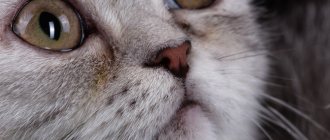Winter is coming: how does a cat’s body prepare for the cold?
These animals prepare in advance for cold weather. To avoid freezing in the cold, they gain weight. Modern cats store fat for the winter, following the example of their wild ancestors, who were forced to survive in harsh conditions.
In addition to increasing body weight, cats' fur becomes thicker and longer in preparation for cold weather. Moreover, in winter they practically do not shed. With the approach of cold weather, these animals wash themselves less often than usual, because wet fur is not able to warm them when necessary.
But how then do street murks survive?
It's terrible, but not everyone survives. Even hereditary stray cats are not able to withstand frosts below 20°C for long. Pack dogs gather closer together, warming each other, and dig holes in the snow. Cats do not know how to dig holes, and do not flock together
If you doubt whether cats are cold in winter, pay attention to how few familiar faces you meet when going to work in the morning: in the summer there is a mug under every car and on every bench, in winter they all disappear somewhere.
Somewhere - these are, as a rule, basements and entrances. Although in recent years, many basements have been tightly sealed, and ordinary doors have been replaced with metal ones with an electronic lock. Of course, from a sanitation point of view, populating basements with stray cats is not the best solution, but for many cats this is the only chance to survive the winter.
Is it just the fur coat?
The temperature at which cats freeze depends not only on external factors and the thickness of their fur. For example, a cat that is accustomed to life on the street can tolerate the cold more easily than a pet that leaves a cozy apartment only for short trips. In addition, many cats are heat-loving from birth, and even if the owner does not spoil the sissy, they freeze at the slightest frost. Such pets, even when the room is well heated, always huddle close to the radiator or try to crawl under the blanket, sit with a ruff, sleep a lot and move little, dreaming of a warm summer. Of course, it is unlikely that cats are afraid of the cold in the same way as people, but the belief in nine lives and extreme resistance to any disasters is a clear delusion.
Animals, in particular cats, are not as sensitive to temperature changes as people, thanks to their fluffy and thick fur coat.
Many pets that their owners let out for walks ask to go outside in any weather, and a cold frosty winter is no exception. But, if in the warm season the owners do not worry about the health of their furry pets, then in the bitter cold they are a little afraid to let them outside.
Are there any grounds for such fears and what sub-zero temperatures can cats withstand without freezing or frostbiting their paws or ears?
Other useful tips
A pet that eats high-quality, balanced food will survive sub-zero temperatures much easier. When cold weather sets in, energy costs for heating increase
Therefore, it is recommended to pay attention to the diet, especially for kittens and older cats. In winter, it is necessary to increase the calorie content of the menu, add complete proteins and fats
These substances are found in sufficient quantities in meat and dairy products.
Homeless animals rarely eat healthy food, so it is natural that not all will survive in the cold and severe frosts. Therefore, if abandoned cats live in the yard or nearby, you should try to help them cope with bad weather. You can feed the strays with leftover food or give them inexpensive dry food. Particularly compassionate cat lovers make them a primitive shelter where the animal can hide from snow, wind and severe frost. But if the cat is cold and all the signs of hypothermia are visible, you should not leave it to suffer outside, because the body will not stand it. A rescued animal can become a new member of the family and find caring and loving owners.
Changing Animal Behavior
Sensing the imminent approach of winter, cats turn on energy saving mode. No matter how active and playful a pet is, with the onset of the first cold weather it turns into a couch potato, spending most of the day on a soft bed or near a warm radiator. This behavior is especially typical for four-legged dogs with short fur. They prefer to make themselves a cozy nest somewhere in the closet or crawl under the blanket.
With the approach of cold weather, cats' appetite increases, and even little ones with tails are not averse to once again enjoying the treat offered by their owners. As noted earlier, the increased interest in food in these animals is associated with the need to increase the layer of subcutaneous fat, which will help them survive in the most severe frosts. There is no need to worry about this, much less put your pet on a diet. When difficult times pass, his appetite will normalize, and his weight will gradually return to normal.
Diet
Cats naturally lose their appetite in hot weather, which is not a concern for you or your family. The pet does not need to be persuaded to eat, much less force-fed. At high temperatures, a cat can remain absolutely hungry for about a day, a kitten for no more than 12 hours. Naturally, your task is to make sure that the cat drinks enough water and visually looks healthy.
Meal times should be moved to earlier in the morning or late evening. It is advisable, during extremely high temperatures, to switch the cat to a single meal and feed the pet in the evening. At night, when the air temperature drops, the cat needs energy to stay warm. During the day, it will be difficult for the patient to cope not only with the heat, but also with digesting food.
With a natural diet, all heavy foods should be excluded from the diet, and the amount of grains should be kept to a minimum. Beef, pork (if you give it to a cat), lamb should be replaced with rabbit, chicken or quail meat. Remove food from the bowl as soon as the cat is satisfied, because in the heat, it will take several hours for the food to disappear and there is a risk of poisoning.
Winter for domestic cats
Behavior
As sunlight decreases, cat activity also decreases. “Move less, eat and sleep more”
- that's their slogan for this time of year. Four-legged pets become calmer and lazier, preferring a secluded warm corner to games. With the arrival of winter, the ratings for warm blankets, shelves in the linen closet, radiators and heaters rise. To reduce heat loss, the cat curls up into a ball, wrapping itself in its fluffy tail.
Physiology
Nutrition.
One of the means to combat the coming cold is the accumulation of subcutaneous fat. Cats begin to eat more, but move less. And therefore, a caring owner must find a middle ground between natural requirements and reasonable necessity. After all, a four-legged couch potato hardly needs a thick layer of fat that protects from frost. So are the problems associated with obesity.
Wool.
Usually in the fall, cats actively shed in order to acquire high-quality wool with a thick undercoat for winter. But the human “heating season” blurs the molting picture, prolonging it... sometimes until the next molting. Therefore, your furry pet needs careful care for its coat - regular brushing, paste to remove hairballs from the stomach, and possibly the use of special vitamins (for example, Felvit N, Brewers Yeast) - about this.
Diseases.
With the onset of cold, dampness and drafts, domestic cats' immunity decreases. And they can become prey to colds (upper respiratory tract infections), cystitis (inflammation of the bladder) - the fault is cold window sills and floors. And if you accidentally “forget” your pet on the balcony, the consequences can be more serious, including hypothermia and frostbite. Therefore, it is worth being vigilant - do not let your pet lie or sit in cold and drafty places (or insulate them, making them safe for health) and postpone walks on the balcony until better times. Well, strengthen your immune system with multivitamins, especially with a natural diet. During this period, fresh green grass from the pet store will not be superfluous.
At what temperature does a cat start to freeze?
Cats are one of the hardiest representatives of the fauna. They live on almost all continents, so most of them are adapted to the harshest conditions. However, one should not overestimate the ability of a cat’s body to easily tolerate sub-zero temperatures.
Thick fur, dense undercoat and a thick layer of subcutaneous fat allow these animals to walk outside without freezing when the thermometer drops to 5–10° below zero. They feel quite comfortable even at minus 15–20°, provided that the walk is short. If you stay outside for a long time in such frost, your cat may become hypothermic. In addition, she can freeze her ears and paw pads, which are devoid of fur.
It is believed that representatives of the cat family are able to survive at temperatures of -30°. However, in reality this is not at all the case. In such frosty weather they are not only cold, they can die from hypothermia.
Freezing at home?
Usually the temperature in the apartment does not drop so low that the cat can actually freeze. But many owners pamper their kittens by teaching them to sleep near the radiator or under a blanket. Growing up, the pet does not tolerate even a slight drop in temperature: it trembles, clings to the warmth, the cat has cold paws and ears, and loses interest in games. As mentioned above, some cats love warmth from birth, and manage to freeze at room temperature that is quite comfortable even for humans. Sick and aging cats are freezing, kittens and pregnant pets are looking for warmth.
Creating comfortable conditions is very simple. You need to purchase a couple of closed houses or sun loungers with high sides. Inside you can put an old woolen sweater, some kind of fur bag or a baby blanket. The cozy nest should be located near the radiator, but so that the sides of the “dwelling” do not touch it. And, of course, we must not forget about proper feeding, vitamins and monitoring the general condition of the pet.
What cat breeds can't stand the cold?
Oriental cat breeds are extremely heat-loving and will not go outside in the cold.
It is clear that such fluffy cats as Siberian, Maine Coons or Norwegian Forest cats, thanks to their luxurious fur coat, can stay outside for a long time in winter.
But eastern breeds, for example, Abyssinians, Persians or Burmese cats, are extremely heat-loving and for them even five degrees below zero is a good reason not to leave the house.
At what temperature do hairless cats die?
There can be no question of releasing hairless cats in winter! Such exotic pets as “sphinxes” or “bambinos” get very cold and if the animal is outside at sub-zero temperatures, it will certainly die.
Hairless cats should not be allowed outside in winter!
Cold is also poorly tolerated by small kittens, elderly animals, pregnant cats or those suffering from any disease. It is strictly forbidden to let them outside in winter.
In winter, you should be especially careful about your pet and it is advisable to walk him on a leash. After all, if a cat gets lost and cannot find its way home, then it is likely that in severe frost it may die from hypothermia.
When is the temperature too cold?
If you live in warm climates, you don't have to worry too much about your cat freezing to death. The weather here is rarely cold enough to worry about. On the other side of the world, this may pose a different risk. If you live in an area where it snows or gets very cold at night, then it would be wise to find out how well your cat tolerates the cold.
One of the main factors that influences how your cat will handle cold weather is his age and health. If you have an older cat with some health issues, a 4 degree night can be dangerous. An older cat has a harder time fighting off severe colds due to their advanced age. They are always more susceptible to illness and injury. On the other hand, if you have a young, healthy cat, you have nothing to worry about.
© shutterstock
If the temperature drops below freezing, it can cause serious health problems. In such weather, frostbite and severe hypothermia will begin to spread. Even if your cat has a nice, thick coat, it likely won't be enough to reverse the side effects of hypothermia.
Wintering at the dacha: how to organize a shelter for a cat?
If your cat will live at the dacha in winter, you must do everything to prevent it from freezing. For this you will need a cat house. You can buy it ready-made or make it yourself. This design should be:
- Raised above the ground. You can raise it by simply placing a few bricks, an old pallet or any other unnecessary item under it.
- The outside is equipped with a waterproofing layer that will protect the cat house from rain, snow and other precipitation.
To prevent the animal from freezing inside, the house should be insulated. You can do this in 2 ways:
- cover the walls, ceiling and floor with insulation (for example, polystyrene foam);
- equip the building with heating.
In addition, it is recommended to place a warm bed at the bottom of the room and make the door lockable. The wintering house should not be too spacious, otherwise its occupant will not be able to warm the interior space, since it is the animal whose body produces heat that acts as its main heating system. However, it should not be too small either. In cramped conditions the cat will simply feel uncomfortable.
Frosty cat
This one-year-old cat received the nickname “Frosty” (from the English Frost - frost) due to the fact that he lived for more than a month in a warehouse of frozen semi-finished products, which is essentially a huge refrigerator. This happened in England, in the county of Northamptonshire in the winter of 2010. The “frosty” cat arrived at the warehouse on a truck (he was looking for a warm place to rest) along with packages of carrots and peas. In the warehouse, he ate frozen food for four weeks and licked moisture from the walls. The polar explorer was, against his will, not immediately able to be caught. When this happened, he was taken to RSPCA Woodside, an animal center in Leicestershire. The cat lost his frostbitten tail and ears, but was quite healthy. One of the warehouse workers took the lucky one to his home, and his colleagues raised money for veterinary treatment. (from Gazeta.Ru materials with reference to The Sun)
( 15 ratings, average: 4.27 out of 5)
Do cats need outdoor walks?
Here the division no longer depends on the personal qualities and preferences of the animal, but on the living conditions. As a rule, cats living in the private sector walk all year round. Typically, such pets are equipped with an undercoat and can feel good even in cold weather. Only the owners should provide unimpeded access to the home so that Vaska or Masha, who has been having a good time, does not freeze while trying unsuccessfully to enter the house.
But cats that are not allowed out or are not eager to be “freed” themselves can freeze in the cold. There are frequent cases of pets freezing into ice, frostbite of limbs, ears and tails and other tragic situations. Most often this happens when an unadapted pet ends up on the street - of his own free will or not, and cannot return home.
Cats do well without street walks, and if they have such a desire, you can always use a harness and take out the four-legged reveler. Usually, two or three walks in the cold are enough for homebody pets to cool down their ardor, and they calmly wait for the warmth, looking out of the window.
As you can see, cats are not “walruses” at all, and they will not “harden” unless they find themselves in harsh conditions. Of course, these animals, like all others, are more resilient and strong than humans, but their heat-loving nature is very pronounced. Therefore, if a cat freezes while walking, then most likely she does not need such stressful situations. It’s worth postponing walks until spring!
How can you tell if a kitten or adult cat is cold?
The condition of the body in which the body temperature drops below that required to maintain life processes is called hypothermia. The following symptoms indicate it:
- chills;
- shiver;
- weakness and lethargy;
- pallor of mucous membranes;
- body temperature below 36°.
Prolonged hypothermia of the body of a kitten or adult cat leads to a decrease in the concentration of glucose in the blood. The pet's muscles freeze, heart rate and breathing slow down, and it stops responding to external stimuli. As the animal's condition worsens, the animal collapses, which turns into a coma. If the body is too hypothermic, the cat may appear dead, because its pulse and heartbeat cannot be heard.
Symptoms of hypothermia
What are the symptoms of hypothermia in cats? They largely depend on how far the pathological process has progressed. In most cases, the following clinical signs can be observed:
- Severe and uncontrollable shaking. But it only happens in mild cases of hypothermia. So if you notice that your pet is literally “shaking” from the cold, you can consider him lucky.
- If you put your hand on the skin on a cat's belly, you can feel the cold coming from it. Since the abdomen and groin area are usually the warmest under normal conditions, this simple test is very revealing.
- Apathy, the cat tries to hide in the farthest corner and does not come out, even to eat.
- Lethargy.
- Drowsiness.
- Decreased rectal temperature. This is a very dangerous symptom, since under normal conditions the temperature in the rectum is approximately 0.5-1°C higher than when measured in the ear or mouth. This is observed only in severe forms of hypothermia, in which case it is strongly recommended to immediately show the animal to an experienced veterinarian.
- Slow and shallow breathing.
- Slow heartbeat (bradycardia).
- Inappropriate behavior.
- Coma.
- Death.
Diagnosing hypothermia is quite simple. Firstly, the veterinarian will focus on the clinical picture of the pathology that we described above. Second, he will check your rectal temperature. The lower it is compared to the norm, the faster the animal needs to receive qualified medical care.
Does a cat's fur keep her warm?
Sphynx cats definitely get cold, but what about cats with fur? Pets with a dense, well-developed undercoat are most fortunate in terms of insulation. It is designed to retain natural heat, maintaining the animal's normal body temperature for a long time.
But, as in the case of human clothing, such protection does not last forever: if a person, even warmly dressed, after spending some time in the cold, begins to feel cold, the same happens with cats. If we talk about the temperature at which animals begin to freeze, then everything depends not only on the thermometer readings, but also on other factors:
- whether the pet is in motion or sitting still;
- what is the air humidity;
- is there any wind;
- whether the sun is shining or cloudy, etc.
In “dry” frost, cats do not feel the cold longer, and if the pet does not move, it begins to freeze quickly. With increased humidity, the pet freezes even faster. Practically, in this aspect, everything happens the same as in humans, but with one clarification - cats are superior to people in endurance.
Representatives of hairless breeds and breeds without undercoat are less resistant to low temperatures than cats with “shaggy” coats. Streams of cold air quickly penetrate the skin, but the heat is not retained. When such pets freeze, their ears and limbs become cold, even if the walk does not last long and the thermometer shows a temperature of at least -15°C.
But Maine Coons, Siberians and other cats with good coat protection, especially if they are not too pampered, can safely walk even at -25 - -30°C.
Cat thermoregulation - features you need to know
Most four-legged animals love warmth and gravitate towards the sun's rays even in summer. Cats are naturally hotter than humans, so they expend much more energy to keep their bodies warm. Being warm, the cat feels much more comfortable and calmer because it saves energy.
Despite their versatility in terms of preserving vitality, cats also have weaknesses. With a normal body temperature of 38–39°, cats are much more sensitive to changes in air temperature. Cats don't sweat, so they can't cool down quickly. Dogs, in order to cool themselves in the heat, breathe with their mouths open, while cats open their mouths when their heart muscle is working to the limit or severe oxygen starvation has developed.
How to help a frozen animal?
If your four-legged pet is very cold, you need to start normalizing its body temperature as quickly as possible. In some cases, the slightest delay can cost the animal its life. The actions of the owner of a frozen pet are as follows:
- Wrap the cat in a warm blanket or terry towel. To warm it up faster, you must first hold the blanket on the radiator.
- Place your four-legged pet wrapped in a blanket on a bed near the radiator. Other sources of heat would be useful - heating pads, bottles of hot water, which should be placed around the four-legged frostbite.
- Close all windows and doors in the room in which the frozen animal is located. There should be no drafts in it.
- Dry your pet's fur with a hairdryer if it gets wet in the rain or snow.
- Stay close to the cat until it warms up.
- Feed the warmed animal warm, preferably liquid food.
What you should not do in this situation is try to warm your four-legged pet in hot water. Water procedures in this state are strictly contraindicated for him. He will only freeze even more and may get a serious cold.
What to do?
The cat urgently needs to be warmed up. In case of slight hypothermia, cover with blankets. For more significant cases, wrap your head up and add other heat sources (a heating pad, a bottle of warm water), applying them to your body. Cases of severe hypotomy require urgent veterinary care, as droppers with warm solutions, warm pleural lavage, increased air temperature in the ventilator, and the administration of painkillers are necessary (due to severe pain while restoring tissue sensitivity). In the future, a comprehensive examination of the animal should be carried out in order to begin treatment for the disorders that have arisen in its body.
Frostbite
The cat's paw pads, tail and ear tips are most sensitive to low temperatures.
Superficial frostbite affects only the skin and subcutaneous tissues, which initially turn pale. As blood circulation is restored, the skin turns red, swells and peels. More severe frostbite causes blisters with clear or milky fluid. Frostbitten areas are bordered by a clear line of demarcation from living tissue.
We suggest you read: What to do if a cat scratches its neck until it bleeds
Deep frostbite is characterized by death of the skin, subcutaneous tissue and muscles. In especially severe cases, tendons and bones may be affected, and tissue rejection to a great depth may be observed. First, blisters containing blood form, which turn into black scabs within two weeks. Deep frostbite leads to complete necrosis (death) and tissue loss.
If sensitivity and normal skin color remain in the affected area, and if pressure is applied to it, a hole remains, the prognosis is favorable. If the skin feels wooden to the touch, has bluish lesions and blisters with blood, and there is no trace left on it after pressure, tissue necrosis is possible.
What to do? The affected area should not be rubbed, especially with snow, so as not to damage the tissue further and cause infection. You can quickly warm the affected area by soaking it in warm (not hot!) water or constantly applying a warm, damp towel to it and lightly massaging (without rubbing) until the tissues become red. Then carefully dry and apply a loose bandage. For further treatment, it is better to contact a veterinarian.
For superficial frostbite, you can use the “Rescuer” balm, protecting the affected area from licking (for example, using a protective collar).
https://www.youtube.com/watch?v=xmtC6M29Zxs
Blisters with clear fluid are opened and an anti-prostaglandin drug (such as aloe vera juice) is applied. Hemorrhagic (blood mixed) blisters are not touched. The animal is prescribed non-steroidal anti-inflammatory drugs, drugs to improve blood circulation, and antibiotics to prevent infection. Dead tissue is removed surgically.
Once outside, the cat will panic
It will fail, of course, if you put it for the first time in the middle of the yard, where restless children are running around screaming on the playground, dogs are sorting things out near the fence, and teenagers are perched on a bench with a guitar. Carry your cat in your arms, or if she doesn't like it, in a carrier, to the quietest and most peaceful place in the area.
Better yet, take it to the park, where you will find the most picturesque lawn with short grass. Don't forget to bring water and your cat's favorite treat. For the first time, limit yourself to a 10–20-minute walk, increase the time gradually.
Treatment of hypothermia in cats and dogs in a veterinary clinic
What diagnostics may be needed?
- General blood test (it will reveal the degree of inflammation, the state of the red blood, whether there is anemia or not).
- Biochemical blood test (will help assess the function of internal organs).
- X-ray (will show the condition of the lungs, the degree of their damage, as well as the condition of the bone tissue).
- Ultrasound examination (will help check the structure of the abdominal organs).
How to prepare a cat for a walk
If you decide to take your cat for walks, purchase an anti-flea collar and a cat harness at the pet store (you can use a harness for kittens and miniature cats). Cats have weak neck muscles, so a dog collar cannot be used. A leash, however, is a prerequisite for a walk “without consequences”: cats react quite violently to sharp sounds and perceived threats. And the slightest fear can lead to a rapid flight or attempt to climb a tree.
Before you go for a walk for the first time, accustom your cat to a harness - first put the “harness” on him and let him get used to it. Then attach the leash and walk around the apartment with the cat. After the animal stops getting nervous and trying to rip off its harness, you can try to go outside with it.
The cat will be terribly scared!
Of course, she will be scared if you, out of the blue, put a collar or harness on her and, attaching a leash, drag her with shouts: “Follow me! Forward!" First, you need to gradually accustom your cat to the new accessory. Let her first get used to the fact that she is wearing something and... safely forget about it, like a dog forgets about its collar.
It may take several days or weeks, during which the cat will simply walk around the house in new clothes, sleep and play in it. Then you can attach a leash and, just as gradually, without allowing any tension at first, teach the cat that its movements are controlled.
Winter for walking cats
Everything is clear with street cats - they take care of their own salvation in the harsh winter. Their favorite places are basements with warm pipes, attics, and entrances. During this period, they especially need human support!
For domestic cats living in the yard or walking outside, the best recipe for safely surviving the cold is... being in the owner’s warm home. It's very simple - at sub-zero temperatures it is better not to let the cat out of the house!
Some owners leave their cats outside the house, thinking that they are adapted to life outdoors. Unfortunately, this can put the animal at risk of serious illness.
What temperature is acceptable for a cat to stay in the cold?
temperature is -20° C. Weather conditions also play an important role - strong winds and high humidity aggravate the frost. Of course, each animal has its own limit depending on its health, age, coat condition, nutrition, fat layer, immunity in general, etc. There are cats that can withstand 30-degree frosts, while for others -5°-10 is enough. ° to get serious problems.
Recommendations for the winter period:
- In winter, good coat and skin are especially important for outdoor cats. Therefore, you can introduce additional fatty acids into her diet, for example, fish oil, as well as vitamins E and B-complex.
- Strengthen your cat's diet by adding additional nutrition and increasing the protein in it.
- If the cat is aged, you should, if possible, facilitate its movements associated with jumping, climbing stairs, etc., in order to relieve stress on its joints, which become sensitive at low temperatures.
- Fireplaces and heaters should be shielded to protect your cat from fire, ash, smoke and electrical wiring.
- Be careful about caring for your pet's fur. Wet fur does not retain heat, so cats bathe less often in winter. The formation of tangles should not be allowed. A good fur coat will protect your furry pet from the cold.
- Water and food must be fresh and not frozen. You should not use metal bowls in winter.
- If the cat lives in the yard, it should have a reliable place protected from the cold. A cat's home should be large enough for her to turn around, but small enough to retain body heat. The floor should be raised off the ground and covered with shavings or straw. The entrance of the house should be turned away from the wind, the roof and door should be covered with waterproof plastic.
- In winter, cats sometimes roost in the garage. It should be remembered that antifreeze is deadly to them. And before using the car, you need to make sure that the cat is not sleeping under its hood.
- With the onset of significant frosts, take your pet home!
Help your pet stay healthy during the long cold months!
Cats hate any embarrassment!
Of course they hate it! They hate a lot of what life next to a person forces them to do. But still not so much as not to put up with it for the sake of the benefits that coexistence brings them. For example, delicious food. Did you guess it?
Walking on a leash is an element of training, and correct behavior must be rewarded. Praise your cat for her calm and indifferent attitude towards the harness and leash, give her treats, and rejoice in her successes. And when she truly feels the joy of walking, she will love her leash and will express impatience when it is in your hands.











